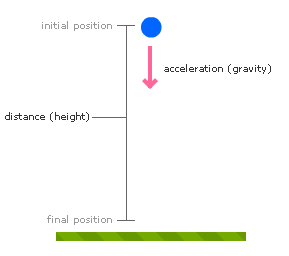Falling Body ! - Physics
 A body travels half of its total path in the last second of its free fall (starting from rest). What is the total duration of the fall of the body in seconds?
A body travels half of its total path in the last second of its free fall (starting from rest). What is the total duration of the fall of the body in seconds?
This section requires Javascript.
You are seeing this because something didn't load right. We suggest you, (a) try
refreshing the page, (b) enabling javascript if it is disabled on your browser and,
finally, (c)
loading the
non-javascript version of this page
. We're sorry about the hassle.
8 solutions
That's pretty much how I did it too. I ended up with
t^2 - 4t +2 = 0
I couldn't solve the quadratic equation, so I just plugged in the choices, and 3.4 approximately worked.
Log in to reply
If you can't solve a quadratic...please die!!
You should check the quadratic formula on the net, which directly solves any quadratic equation.
Log in to reply
Yes I know its Shridharacharya's formula!
Use sirdhar Acharya formula
Shivansh, how did you arrive to these equations?
Augh! Got the quadratic right, then added 2 and sqrt(2) to 4.8 somehow..
From where did u get this question?
Log in to reply
I saw this question in Mc-Graw Hill
itns law of motion
Let s be total path distance & t be the total duration of the fall of the body in seconds.
S(t)=s=ut+(1/2)gt^2=(1/2)gt^2.................(I) (since u=0)
S(t-1)=(1/2)g(t-1)^2.......................(II)
(I)-(II) gives,
S(t)-S(t-1)=(1/2)g(2t-1)=s/2 (Distance travelled in the last second of its free fall)
i.e. s=g(2t-1)
substituting value of s in (I), we get
g(2t-1)=(1/2)gt^2 which implies,
t^2-4t+2=0 which is quadratic in t.
Hence, t=(4+√(4^2-4×2×1))/2=(4+√8)/2=(4+2√2)/2=(2+√2)=3.414≈3.4
Since t>1, t=(2-√2) is not considered.
Therefore, t≈3.4
I even didn't understand ur question. what this last sec of free fall?
The distance travelled by the body in the n t h second is given by S n = u + 2 g ( 2 n − 1 ) . We also know that S = 2 1 g t 2 It is given that at the last second it covers 2 S 4 g t 2 = 2 g ( 2 t − 1 ) ⟹ t 2 − 4 t + 2 = 0 ⟹ t = 2 + 2 ≈ 3 . 4 1 4 sec
in the first sec the body travels @ half the speed , it would travel in the next second, so approx double the last sec ie 2 secs and the last sec ie about 3
We know ,
Time of Fall 'T' = 2 H / g - 1
Displacement of a body in the nth second of its motion :
'S' = u + a × ( n − 2 1 )
We know in the last second :
T = 2 H
Displacement of the body in the last second :
2 H = g × ( T − 2 1 )
Solving the equation we get :
T = 2 g H − 2 1 - 2
Substituting the value of 'T' in equation - 1
We get H 2 / 4 g 2 − 4 g 3 H + 4 1 = 0
Solving the Quadratic equation we get H = 3.23 u
T = 1 2 . 9 2 = 3.6 approx
Note : Here I used g = 10 and by using g = 9.8 we could get a value very close to 3.4s
if u solve this prblm
logically the body travels half of total its path in last second of its free falll
it means that aceeleration will be more due to gravity
timee will be less
the more speed lesser the time
Wrong concept
Gud question please post some more of this type
x = 1/2 g t^2
1/2 x = 1/2 g t^2 - 1/2 g (t-1)^2
Solve for t.
Or since the question is multiple choice, make an estimate:
In 1 second, an object falls 4.9 m. For simplicity let's call that distance L. In 1 second, an object falls distance L.
In 2 seconds, an object falls distance 4L. In the first second it fell L, so in the second second it fell 3L.
In 3 seconds, an object falls distance 9L. In the first two seconds it fell 4L, so in the last second it fell 5L.
In 4 seconds, an object falls distance 16L. In the last second it fell 7L.
The last second being half of the total occurs somewhere between 3 and 4 seconds for the total time falling.